 Tasting No 262 – February 27, 2024 – Wines from Sicily
Tasting No 262 – February 27, 2024 – Wines from Sicily

Source: https://www.winetourism.com/wine-maps/#Wine-maps-of-Italian-wine-regions
-
Tasting Overview
The main objective of this tasting is to explore wines from the Sicily in Italy. The tasting will include one white wine and three reds. All wines for this tasting are Denominazione di Origine Controllata (literally Controlled Designation of Origin) – a certification applied to Italian wines that have distinctive features of superior quality, determined by the grape varietal and the production area as well as the techniques for processing and aging.
Type of tasting: Open
Presenters: Clara Estrada and Jorge García
Participants:
S. Ardila; M. Averbug; J. Brakarz; J. Claro; R. Connolly; C. Estrada; M. Fryer; J. García; N. Marzella; O. Mason; C. Perazza; J. and L. Redwood; J. Sanchez; R. Santiago; E. Silva; L. Uechi; G. Zincke and Patricia Uribe Mallarino (guest).
These are the wines:
- Tornatore Etna Bianco 2019
- Tornatore Etna Rosso 2019.
- Tornatore Etna Rosso Pietrarizzo 2019.
- Cottanera Etna ‘Diciassettesalme’ Rosso 2019.
-
Menu
- Arancini (rice balls stuffed with ground beef)
- Linguini with tomato and clams
- Pork loin with herbs
- Coffee and dessert
-
The Sicily Region
Sicily has a warm Mediterranean climate, tons of sunshine, and lots of heat. The red and white wines are fresh, and high in acid. Let’s figure out how the terroir of Sicily helps create this exuberant tapestry.
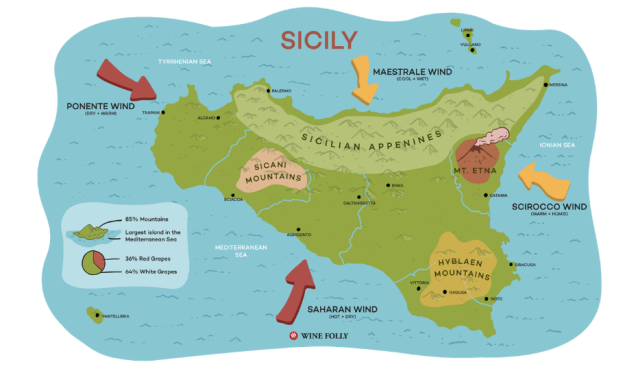 Grapes planted at higher altitudes can produce fresher styles of wine because the grapes have more acid and fresher fruit flavors. Carricante, Catarratto and Nerello Mascalese all thrive at these higher altitudes, found throughout the island. The higher elevation means higher levels of aromas, fresh fruit flavors, lower alcohol levels, and higher levels of acid. That’s because for every 328 feet (100 m) in elevation, the temperature drops 1°F (0.6°C). And with some vineyards sitting above 3300 feet (1000 m), the average temperature can go from 22°C to 16°C. That’s like going from the Central Valley in California, to Willamette Valley in Oregon! The climate goes from really warm, to cool, pretty quickly.
Grapes planted at higher altitudes can produce fresher styles of wine because the grapes have more acid and fresher fruit flavors. Carricante, Catarratto and Nerello Mascalese all thrive at these higher altitudes, found throughout the island. The higher elevation means higher levels of aromas, fresh fruit flavors, lower alcohol levels, and higher levels of acid. That’s because for every 328 feet (100 m) in elevation, the temperature drops 1°F (0.6°C). And with some vineyards sitting above 3300 feet (1000 m), the average temperature can go from 22°C to 16°C. That’s like going from the Central Valley in California, to Willamette Valley in Oregon! The climate goes from really warm, to cool, pretty quickly.
(https://sicily.guides.winefolly.com/terroir/)
The region benefits from Sicily’s ample sunshine, but Mt. Etna’s high 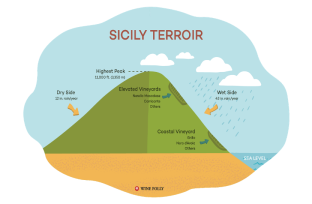 elevation also provides greater rainfall, moderating breezes and cooler temperatures. Etna’s unique nature means soils, microclimates and exposures change dramatically from site to site, creating a panorama of characteristics and possibilities in the vineyards.
elevation also provides greater rainfall, moderating breezes and cooler temperatures. Etna’s unique nature means soils, microclimates and exposures change dramatically from site to site, creating a panorama of characteristics and possibilities in the vineyards.
The wines are from the Etna DOC, which is a stunning wine appellation that covers the slopes of Sicily’s Mount Etna. The appellation is famous for its unique volcanic terroir and distinctive wines.
-
The grape varietals
ITALY, SICILY, ETNA: “THE BURGUNDY OF THE MEDITERRANEAN”
Carricante
The Etna Bianco is born from the skillful vinification of the white grape vines Carricante, cultivated in volcanic soils with a high vocation and arranged in terraces at an altitude of 650 meters above sea level, in the northern slope of the volcano. Straw yellow colored wine with light green shadow that offers mineral notes with menthol scents typical of high wines, green apple with primary aromas characteristic of the variety. (https://tornatorewine.com/vini/etna-bianco-tornatore/).
Carricante is an ancient white wine grape variety from eastern Sicily. It is thought to have been growing on the volcanic slopes of Mt Etna for at least a thousand years. There are around 200 hectares (500 acres) of plantings on the island. Very few vines are found elsewhere. The grape’s synonyms are Catanese Bianco and Catarrato.
Carricante is the key grape behind white wines made under the Etna DOC title. It is required in all of the denomination’s white wines: 60 percent minimum in the standard Etna Bianco and 80 percent in Etna Bianco Superiore. The most common blending partner here is Catarratto, a variety for which Carricante is often confused.
The variety is known for its marked acidity, and the high yields which gave rise to its name (carica means “load” in Italian). The best examples come from vines grown in volcanic soils, at high altitude (Etna’s vineyards stretch up as high as 1,200 meters/3,940ft). Well-adapted to their environment, Carricante vines respond well to the high diurnal temperature variations that characterize the climate around Mt. Etna. The grapes ripen slowly and steadily throughout the long growing season, retaining their trademark high acidity well into September. If harvested too early, this acidity is all too apparent in the wine, and is sometimes countered by lees [1] contact and malolactic fermentation and/or partial barrel aging. In cooler seasons, Carricante grapes can still be seen on the vines into early October.
On the whole, Carricante wines offer a broad range of refreshing citrus aromas – anything from lemon and lime to grapefruit to orange – alongside cooling herbal notes such as mint and aniseed. An underlying mineral, slatey character is also to be found in the finest examples.
When aged in stainless steel and without lees contact, notes of tart green apple shine through – a searing reminder of the variety’s naturally high acidity. Weightier Carricante wines (particularly later-harvested examples) are complemented by honeyed hints and the creamy texture that results from lees contact.
Wine Folly calls the Carricante grape Sicily’s answer to dry Riesling . When tasting this grape, look for aromas of citrus, green apple, orange blossom, and peach, with mineral notes of crushed rocks and salty air. The tasting notes on the wine I tried mentioned white peach, orange peel, crushed thyme and subtle, smoky flavors that mix well with fresh and dried-herb notes. I was thrilled to read these notes, because I quickly picked up on the smokiness and dried herbs. Had I not had those notes, I wouldn’t have been able to name what I was experiencing. https://www.wine-searcher.com/grape-989-carricante ; https://bettyswinemusings.com/what-a-treat-to-try-carricante/ ]
Nerello
Nerello comprises two varieties of red wine grapes grown primarily in Sicily and Sardinia.
- Nerello Mascalese. It is named after the Mascali area in Catania where the grape is thought to have originated. It is grown mainly on the northeastern side of Sicily and is thought to be superior in quality to the Nerello Cappuccio. While it can be used for blending, the grape is often made into varietal wine. Recent DNA testing has confirmed that the variety is the offspring of Italy’s famous Sangiovese grape variety and Mantonico Bianco.
- Nerello Cappuccio. It is widely used in the Etna DOC as a blending grape that adds color and alcohol to the wine. The grape is less prominent and used in smaller proportions, although it can contribute darker fruit flavours, more structure, and deeper colour to the final wine. This is the most common blending partner for Nerello Mascalese, being a small proportion of the blend.
The two varietiess have gained attention in recent years for their role in delivering high-quality, unique wines that reflect their volcanic terroir. Synonyms for the Nerello grapes are Niureddu and Negrello.
Nerello Mascalese is grown predominantly in Sicilia (91%) in an area of about 2,900 has. The area extends across the variable volcanic soils of the slopes of Mt. Etna at some of the highest vineyard altitudes in all of Europe—up to 3,300 feet. The plantings easily exceed the plantings of Nerello Cappuccio. A small portion of older vines predate the phylloxera epidemic of the 1880s Nerello Mascalese is one of Sicily’s most noble red varieties. It makes a beautifully aromatic, firm, cellar-worthy but pale-hued red often comparable to a fine Burgundy or Barbaresco. Nerello Mascalese takes its name from the black color of its grapes, nerello, and the Mascali plain between Mt. Etna and the coast where it is believed to have originated.
The organoleptic characteristics of the monovarietal Nerello Mascalese generally are a ruby red color, with subtle grenade tones; a strong fruity scent of red berry fruits, with slight floral shades, a spicy hint, and a delicate effusion of vanilla and tobacco, with a persistent trace of licorice; and a dry, tannic, persistent and harmonic taste, with a strong body. At sight, the wine seems surely more mature than it appears when smelled or tasted. Treating this vine variety in a traditional way, it can produce a wine presenting the above-described characteristics.
https://en.wikipedia.org/wiki/Nerello https://www.bbr.com/grape-nr-nerello
https://www.wine.com/product/tornatore-etna-rosso-2019/912755#closePromoModal
https://italianwinecentral.com/variety/nerello-mascalese/
https://www.wine-searcher.com/grape-1727-nerello-mascalese
-
The Wines and Their Producers
The Producer #1. Azienda Agricola Tornatore
The Tornatore, one the oldest wine growing families on Mt. Etna, have lived in Sicily since 1680 and trace their Etna grape growing back to 1865. In 1910 the Grandfather Giuseppe built a house with a millstone in the district of Piano Fiera with adjacent 2 hectares of vineyards in addition to other two hectares on the North side of the Etna, in the district of Piano Felci at 1,000 m above sea level. That heritage and the Tornatore’s profound respect and understanding of the land is showcased in wines that capture the essence of Etna, balancing concentrated flavors, complexity, freshness and refinement. The Tornatore’s Etna roots have long grounded them in the flavors and patterns of their region, and it was this knowledge that inspired Francesco Tornatore to found his family’s winery in the town of Castiglione di Sicilia in 2010, nearly a century and a half after his great grandfather first planted vineyards on Mt. Etna.
Tornatore blends artisan and modern winemaking to craft wines such as the Bianco and Rosso that display the full range of fruit and complex personality of Etna terroir, and single vineyard wines—Pietrarizzo with its high elevation and Trimarchisa with 40-year-old vines—that express the beauty and distinct character of their exceptional sites.
The winery lies in the northern side of Mount Etna, where the soils have volcanic origin and are derived from the disintegration of the masses of lava, ashes and lapilli. Generally, these soils are formed on site (native) or carried by rainwater which, in some flat areas on the slopes of the volcano, resulted in large black valleys, deep and very fertile. The climate on the northern side of the Etna is characterized by mild temperatures, reflecting the influence of the mountain reliefs from that side (Nebrodi). The result is a late maturing environment due to the exposure and the predominant altitude that promotes strong thermal excursions. The combination of soil, climate and the skill of the winemakers, have made the northern slope of Etna an ideal area for the production of high-quality wines.
The Company owns 110 hectares of which 60 hectares of vineyards, making the Tornatore’s vineyards one of the largest in the Etna DOC production area. Tornatore’s vineyards count several locations in different districts: among them the remarkable contrade (districts or parcels of vineyard land that have been known by recognized names for a long time) of Bragaseggi, Piano dei Daini, Zottorinotto, Pietrarizzo, Malpasso, Pietramarina, Torre Guarino, Carranco and Trimarchisa, all in the Castiglione di Sicilia Municipality. The altitude ranges from 550 to 700 meters above sea level and the age of the vineyards varies from 3 to 40 years for the Reds and 3 to 10 years for the Whites.
The winery’s vineyards have recently been reorganized in order to improve the quality standards, with particular attention to the the vineyards management. A high number of vines per hectare (approx. 6,000) has been maintained. The existing vines are Etna’s native in compliance with the rules of Etna DOC wine production, in particular Red Berry Nerello Mascalese and Nero Cappuccio and White Berry Carricante and Catarratto.
Harvest and winemaking: grape harvest is done by hand. Subsequently transported in special crates, the grapes are vinified maintaining high standards of quality, with maximum respect for tradition. The grapes are selected and processed manually to enhance the characteristics of each vineyard. Wines are aged in oak barrels located in a completely buried rooms, with insulation made of Etna basalt blocks arranged on walls and floor of the cellar in a workmanlike manner.
The winery has the latest modern equipment with low environmental impact, maximum respect for the surroundings, including the use of renewable energy sources for its operation. (https://tornatorewine.com/company/?).
TheProducer #2. Cottanera.
The story of Cottanera starts with Francesco Cambria, who, in 1962 bought 100 hectares of vines and hazelnut groves near his birthplace in Randazzo. With the arrival of DOC status for Etna in 1968 and hazelnuts losing market share, he decided to focus on grape growing for bulk wine production, replanting the hazelnut groves to vines. In the late 1980s, Francesco’s son Guglielmo decided to build a winery to make his own wine, rather than selling the grapes, and he was quite successful selling it in demijohns to local consumers and restaurants. The initial success of these wines pushed Guglielmo to progress to quality wine production, so in the mid-1990s, he improved his father’s vineyards and embraced lower yields, and he labeled the first wines as Cottanera. In the mid-1990s the family started focusing on producing premium wines and launched the Cottanera label. Today Cottanera is one of the largest vineyards in Etna, at roughly 65 hectares, with vineyards located in five different parcels on the northern slope of Etna where most of the volcano’s best-known wineries are located. The business focuses on the Etna Rosso, Bianco and single parcel wines that are now gathering most of the attention and which have been known by recognized names for a long time.
6. The Wines
Wine #1. Tornatore Etna Bianco 2019
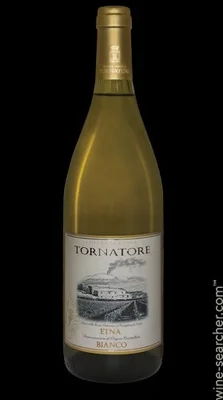
- Year – 2019
- Composition: 100% Carricante
- 12.5 %
- 4-6 months in steel and concrete tanks
- Critical Acclaim, awards: Gold from the Sommeliers Choice Awards (2019 vintage)
- Winemaker’s notes: Pale straw yellow with intense greenish reflections at the sight; pleasant hints of green apple, grapefruit, white peach and aromatic herbs, mark the nose of this wine which shows its true identity on the palate with a very pleasant flavor and freshness completed by an extraordinary minerality; exclusive notes that invite a second glass.
- Critic notes. “The nose on this Etna white is like walking through a lavender field on a sunny afternoon—fresh and floral and warming—before blooming with more flowers, from lily of the valley to peach blossoms, and saline notes of sea air. The palate walks the same path through flower fields to the waterfront, salty and floral, with peach and pear notes as well, balancing depth and delicacy”. (Danielle Callegari – 91/100, Wine Enthusiast).
Wine #2. Tornatore Etna Rosso, 2019

- Vintage: 2019
- Varietal: 95% Nerello Mascalese; 5% Nerello Cappuccio
- 13.5-14%
- 6 months in big wood barrels and 3 months in bottle
- Awards: Ranked among the top 10 wines from the region with respect to number of awards won: the 2019 vintage was awarded Gold from The TEXSOM International Wine Awards, and the 2017 vintage was awarded Gold from the Sommeliers Choice Awards.
(92 pts. Wine Spectator; 91 pts Wine Advocate)
- Winemaker notes. “Ruby red with faint purple, typical of this variety which is not very rich in color. Clear hints of red berries, morello cherry and black cherry on the nose. The taste is characterized by its typical balanced tannins and a surprising fullness, flavor and persistence.”
- Critic notes. “The Tornatore 2019 Etna Rosso is a blend of Nerello Mascarello with a 5% touch of Nerello Cappuccio added to give a bit more color to the wine. In fact, “Nerello” is a diminutive of the word “nero” (or “black”) and underlines the grape’s light appearance. This entry-level wine is aged in oak for eight months to show dark cherry, spice and blue flower. Fruit comes from young vines that are 10 years old. Drink: 2023-2027”. (91/100 pts. Monica Larner @ Wine Advocate)
Wine #3. Tornatore Etna Rosso, ‘Contrata Pietrarizzo’, 2019

- Vintage: 2019
- Varietal: 100% Nerello Mascalese
- 14-14.5%
- One year+ in 25 hl. wood barrels and cement tanks; 3 months in bottle.
- Winemaker notes. Ruby red, delicate and incredibly balanced on the nose, clear hints of red berries, flowers, perfectly integrated to a minerality and evolution worthy of a great wine. Great structure on the mouth with a surprising drinkability and elegance. Serving temperature 18 °C.
- Critics notes. “A graceful, medium-bodied red, with bright acidity and fine, creamy tannins, which buoy a pleasing range of baked strawberry, star anise, graphite and red licorice notes. A subtle overtone of herbs and mineral pushes through and lingers on the lightly chewy finish. Drink now through 2032”.( 93 pts. Wine Spectator)
- “Etna Rosso “Contrada Pietrarizzo” by Tornatore is a full-bodied and pleasent persistent red wine. The nose is fruity, rose spirit, elegant and mineral spices. On the palate it is juicy, balanced and soft, with tannins provided a pleasant persistence”. https://www.callmewine.com/en/etna-rosso-contrada-pietrarizzo-tornatore-2019-P43050.htm
Wine #4. Cottanera Etna ‘Diciassettesalme’ Rosso, 2019
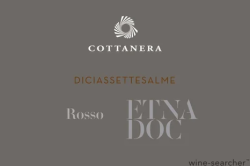
- Vintage: 2019
- Varietal: 100% Nerello Mascalese
- 8 months in French oak barrels
- 14%
- Critic notes. “Aromas of French oak, toasted nuts and spearmint lead the nose. The aromas follow over to the linear palate along with coffee bean, licorice, salty notes and blood orange before close-grained tannins sneak in and dry out the close”. (Kerin O’Keefe” – 89/100, Wine Enthusiast).
- 7.CV Members Rating
The tasting took place before revealing their prices. 16 participants rated them from Mediocre to Excellent.
The combined results established the preference order during the tasting.
Tornatore ‘Etna Bianco’ DOC, 2019 and Cottanera ‘Etna Rosso Diciassettesalme’, 2019 were both rated the Best Wines and the Tornatore ‘Etna Bianco’, 2019 the Best Buy. The following Table presents the details of individual ratings and combined results.
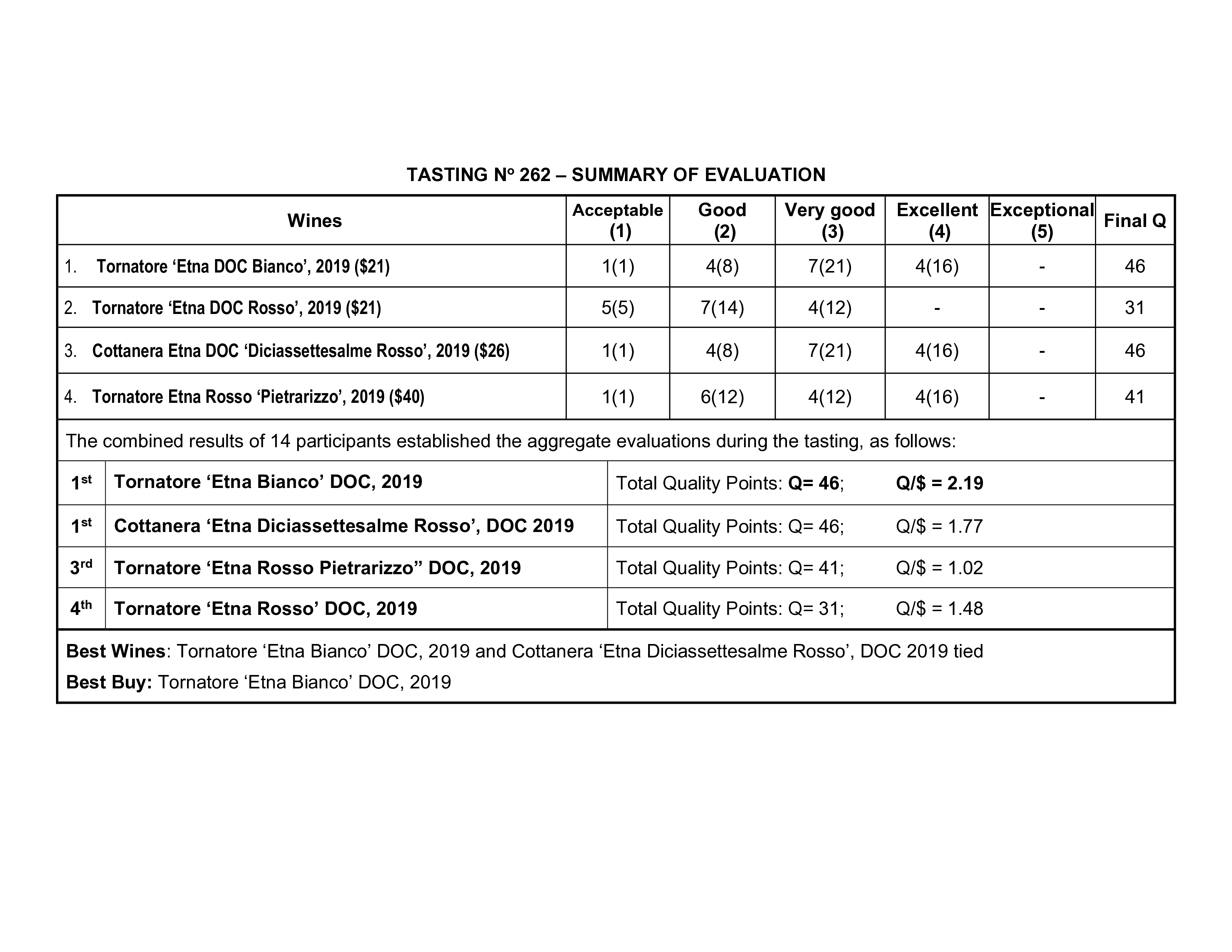
.o0o.
Laughing matter:

*
.o0o.
